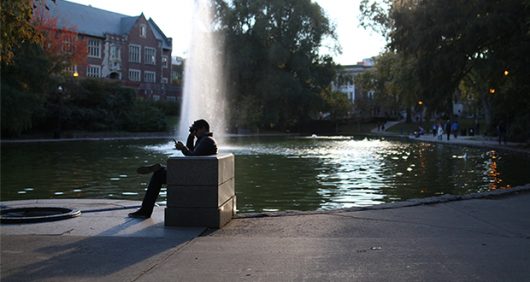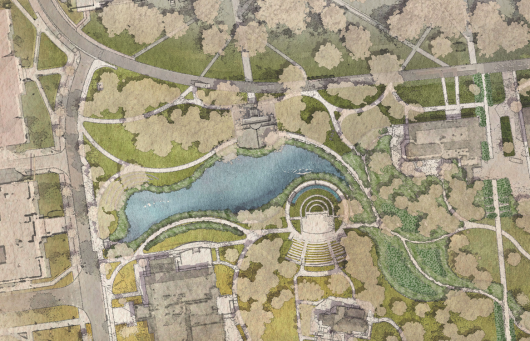
Work on Mirror Lake is set to begin Tuesday, with renovations likely to bring the pre-Michigan jump tradition to an end. Credit: Mason Swires
The tradition of jumping into Mirror Lake could come to an end under an Ohio State plan to drain and renovate the surrounding area.
Work on the lake, which is set to begin Tuesday, will likely take about 18 months according to university officials. Plans to install wetland marshes around the lake could make future jumps — which have taken place before the OSU-Michigan football game in November in recent years — difficult, if not impossible.
Last year, Austin Singletary, a third-year in human nutrition, died after sustaining injuries he received while jumping into the lake. As a result, Undergraduate Student Government voted to support ending the jump, and OSU’s administration put out a statement saying it would work to put the tradition to an end.
OSU spokesman Chris Davey said the intention of the redevelopment — which contains both aesthetic and environmental aspects — is not in reaction to the tragedy or to stop the Mirror Lake jump, even if the timing of the construction accomplishes that goal.
“The jump ending is a consequence of the construction, but not the driving factor in restoring the grounds,” Davey said. “This is the culmination of years of planning and discussion that involved the student body.”
When asked about plans for the jump during a September meeting with The Lantern, University President Michael Drake said there were discussions surrounding what would be done, though he didn’t mention the years of planning.
“We are having discussions with a variety of people on campus and off campus about that, and that’s something that I then can’t talk about, because I don’t want to get in the way of those discussions,” Drake said at the time.
Gerard Basalla, president of USG and a fourth-year in political science and strategic communication, said that students need to realize the jump is over.
“Put it to bed. It’s important that students move forward and don’t try to jump,” he said. “You can’t have a tradition where someone dies. You can’t do it.”
Basalla said students have a right to be mad about the jump ending, but it is something that needs to happen to keep students safe and prevent possible injuries.
Basalla said USG is not planning to create a new tradition to replace the Mirror Lake jump, though that was included in the resolution USG put forward when it voted to end the jump.
The new designs of the lake would make it nearly impossible for students to jump in, said Keith Myers, associate vice president of planning and real estate in OSU’s Office of Administration and Planning.
The altered lake will extend farther east toward the South Oval and will have an eight-to-ten-foot shallow wetland around its edges.
“There won’t be anything to jump into,” Myers said. “The lake is going to be inches deep at the edges, and it’s going to be full of wetland marsh.”
In addition, a new drainage system will be built, which can drain the lake in less than a day. It currently takes multiple days for the lake to fully be drained.
A forum in 2014 with more than 200 people in attendance, including faculty, staff, students and alumni, was one of the first opportunities for students to have a say in what the new Mirror Lake might be.
“Faculty leadership were involved in the early phase discussions, which began about two years ago,” Davey said, noting consistent participation from Drake.
After the faculty discussions and forums surrounding the lake, a consensus was reached to restore the lake to a design reminiscent of its original state, but no definitive concepts were made until recently, said OSU Provost Bruce McPheron. The vision of the renovation is to make Mirror Lake look as it did in the 1870s when it was a natural hollow, rather than a constructed body of water.
“What we’re looking to do is create a concept that really distinguishes the hollow and takes the lake and reshapes it a bit. Not exactly like the 1870 layout, but along the lines,” Myers said. “It’s kind of longer, thinner, fits more comfortably into the edges of the hollow than it does today.”

An artistic rendering of what Mirror Lake and the surrounding area might look like once construction is completed. Credit: Courtesy of Ohio State
To coincide with the sustainability goals of OSU, the renovations of Mirror Lake are designed to fix old problems and prevent new ones from occurring.
“When Mirror Lake was expanded to its current shape, it began to push hard against all of its edges,” Myers said. “That was one of the issues in and around Pomerene as a result.”
He said that this previous expansion of the body of water made some of the original walkways, paths and steps inaccessible, including those that used to lead to Pomerene.
As well as promoting the biodiversity of certain trees that have been preserved in the area, he said the redesign of the lake would allow for more stormwater treatment to take place.
In addition to the focuses of the renovations being sustainability and convenience at the forefront of the reasoning behind the Mirror Lake closing, the administration also said the lake construction coincide with renovations of the adjacent Pomerene Hall and the Browning Amphitheater.
This construction project, slated to go past $4 million and thus require Board of Trustees approval past that point, is set to be introduced at the next board meeting, Davey said, but investigation of the properties of the lake will begin once it has been drained.
“There’s a lot of conditions we don’t know — the soil conditions underneath the water and what kind of clay we have down there,” Myers said. “There’s a lot of unknowns that we’ve got to get into.”
McPheron said that he is prepared to hear a variety of opinions regarding the renovated lake.
“Our response will be to listen to those conversations,” McPheron said. “We were very clear last winter that there would not be a jump this fall. That’s unambiguous and unwavering that there would not be a jump this fall.”
Nick Roll contributed to this article


